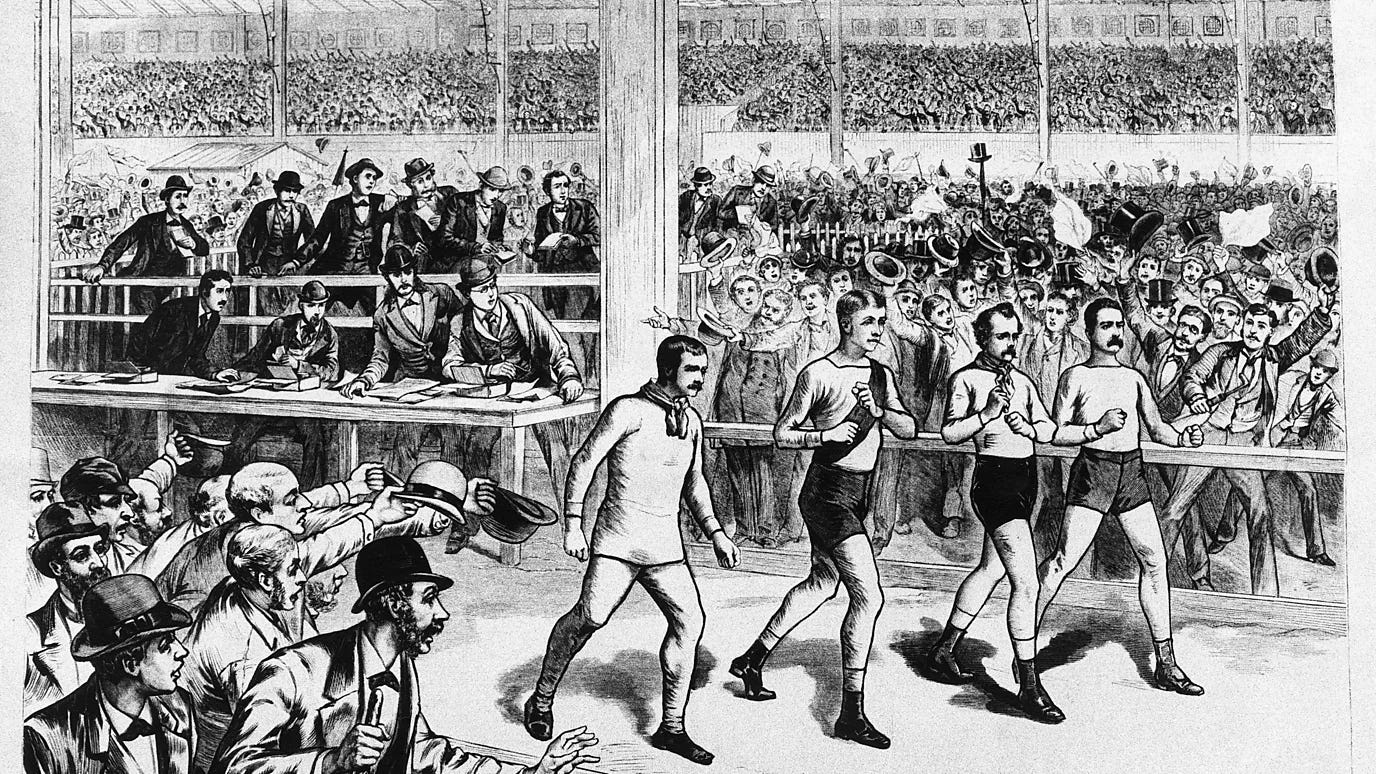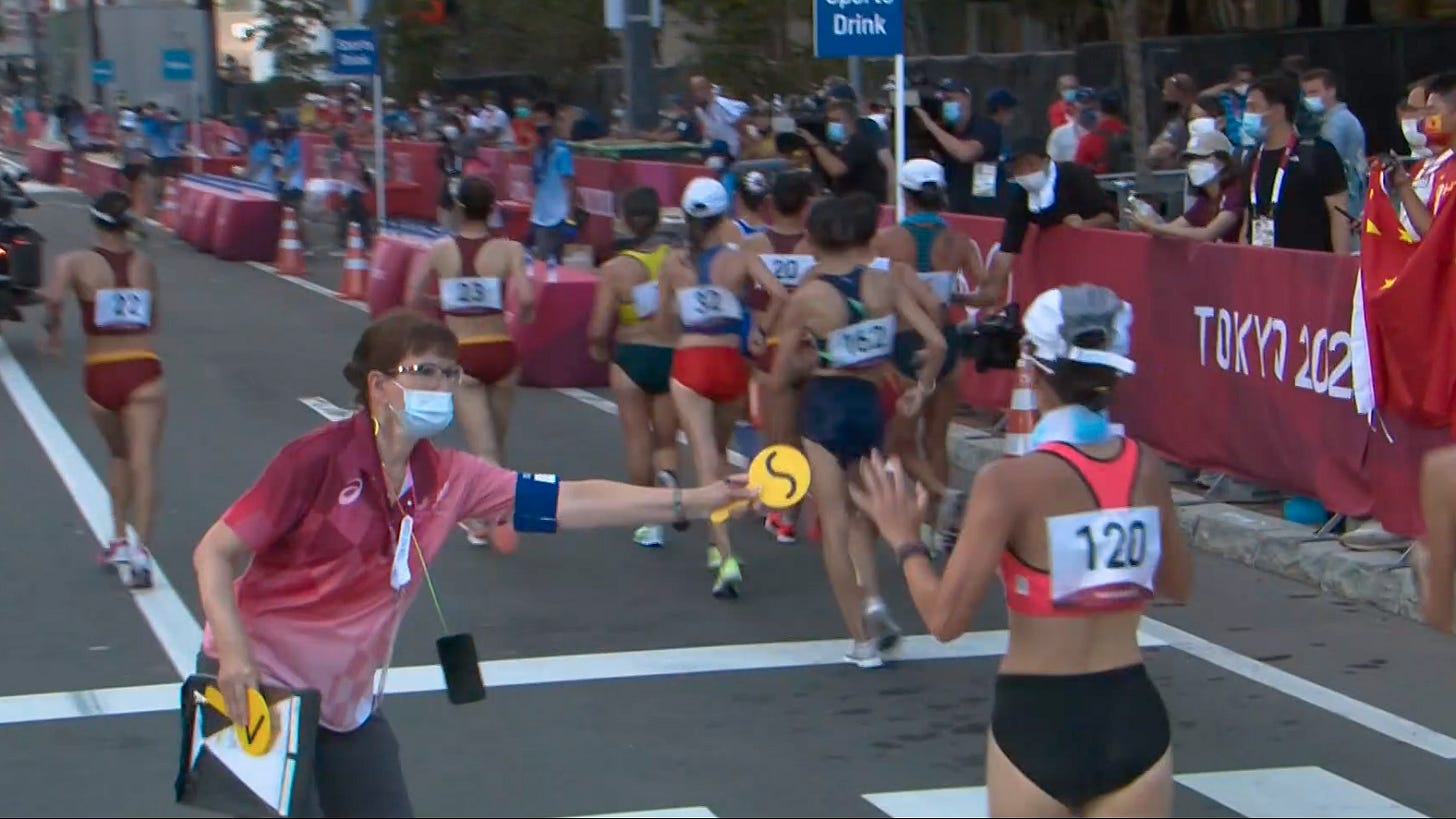We are NOT done talking about strange, niche sports that are somehow actually in the Olympics year after year! Today we are lucky to have a guest post from Molly Blondell, who is a burgeoning scholar of environmental justice by day and a superfan of race walking by night. We love you Molly!!
Hey folks, tapping in while Lindsey enjoys the wonders of the Mall of America!
My self-proclaimed obsession with race walking came about during the 2008 Beijing Olympics. Experiencing a bout of Olympics-induced insomnia, I decided it would be prudent to watch whatever events were currently airing at 2am Eastern Time. Lo and behold, I caught the start of the Women’s 20km Race Walking where Olga Kaniskina took an early lead in an unrelenting downpour, and somehow kept it throughout the entire race and won gold.1
Race walking captures the intensity of competition, the drama of cutthroat (yet silly) rules, and, when the weather warrants, the image of athletes race walking through misters and dabbing themselves with sponges.

A Brief History of Race Walking
Origins of race walking are traced back to pedestrianism, which was the Victorian-era human NASCAR that swept the nations of Britain, Ireland, Canada, and the United States through the end of the 19th century.
Though different events catered to different rules/structures, the standard contest required athletes to move around a track until they had completed laps equivalent to at least 450 miles (which usually amounted to six days in a row of walking). In this era, athletes were allowed to run, walk, promenade, or even crawl so long as they did not leave the track until the race was over. Instead they ate, drank, and napped (and presumably, performed other bodily functions) in little tents at the side, some of which were elaborately furnished.
While athletes raced around the track, spectators would gamble, eat snacks, and generally vibe.
“It was a real spectacle. There were brass bands playing songs; there were vendors selling pickled eggs and roasted chestnuts. It was a place to be seen.”
—Matthew Algeo, Pedestrianism: When Watching People Walk Was America's Favorite Spectator Sport.

However, with the rise of more modern spectator sports and the fact that more ~RuLeS~ were being added to the structure of pedestrian contests, the sport became less interesting for rich people to gamble on, and pedestrianism gradually transitioned from spectacle to an organized amateur athletic competition: race walking.
Race Walking in the Olympics
The first stand-alone race walking events debuted at the 1908 London Olympics, which featured 3500 m and 10-mile distances.2 After a good amount of shifts in actual distances of the event that aren’t really too interesting to discuss, the 50km distance became a standard from 1932-2020, with the 20km distance being added as another standard at the 1956 Melbourne Olympics.
Realizing that women are also capable of walking at fast speeds, the IOC added a 10k race walking event for women in the 1992 Barcelona Olympics. The event was then lengthened to its current 20km distance beginning in the 2000 Sydney Olympics.
The latest development in the saga of ever-changing Olympic race-walking events is that there is going to be a 50km mixed-gender team relay for race walking. Men and women will bravely walk on the course at the same time(ish)!
Think Goose!: Mechanics and Rules of Race Walking
Race walking to the Olympics is like looking at a piece of modern art in a museum. It is deceptively simple and makes the common person think that they are capable of excellence in the medium they are criticizing despite never earnestly trying it.
The foundational mechanics of race-walking are, essentially, Think Goose! (with haste).
Despite being one of the many sports where the simple goal is to get from Point A to Point B, there are two particularly nit-picky rules that make competitive race walking ruthless:
Race walkers must always have one foot firmly in contact with the ground at all times, as visible to the human eye by course judges.3 If a judge deems there is no visible contact, then a race walker will receive a ‘lifting’ penalty.4
As directed by the “straight leg rule,” race walkers are not allowed to bend their knee when the supporting foot contacts the ground until their other leg passes under the body’s center.
These rules are upheld by a number of Judges (five to nine, depending on the length of the particular race walking event), who are stationed throughout the course to inspect racers’ adherence to the rules with their naked eyes. They administer their judgements with paddles: ~ (for ‘loss of contact’) and < (for ‘bent knee’).

However, as athletes in any sport may find loopholes or shortcuts, race walkers know they can test the limitations of the judge’s reasonable abilities to… see(?):
“Your eye can catch anything that is slower than 0.6 seconds, so the quickest lifter is going to be okay within the rules. You have to push the envelope, you want to be on the edge.”
—Canadian race walker and Olympian, Iñaki Gómez, speaking with authority on something I will not be fact-checking.
There are risks to this, of course, as race walking judges are known for being discerning and, if a race walker receives three (3) warnings (paddles) from different judges, they are disqualified from the race with a very anti-climactic-yet-still-dramatic red paddle, as was the case during the 2016 Rio Women’s 20km event where six race walkers were disqualified for their repeated infractions.

Iconic Olympic Race Walking Moments
At the 2000 Sydney Olympics’ Men’s 20km Race Walk, Mexican athlete Bernardo Segura received three warnings, resulting in his disqualification. However, chief race walking judge of the event, Lamberto Vacchi, was too busy disqualifying another athlete on the course to disqualify Bernardo before he finished… in first! Thinking he won a gold medal, he was super excited and even took a phone call from the President of Mexico while on the track. Our dearest Lamberto waited until the phone call with the President was finished (which apparently was 15 minutes after he crossed the finish line) to tell Bernardo that he was actually disqualified. The President of Mexico, unwilling to make a phone call to anyone who is not a gold medalist in race walking, complained to the then-IOC boss and filed a complaint with CAS… which did not overturn anything but really ensured that all parties were being messy.
Yohann Diniz of France is likely the most well-known Olympic race walker based on his determination and unfortunate bowel movements during the 2016 Rio Olympics. Leading the race by 1:28, Diniz began experiencing some extremely unfortunate digestive issues. He continued to power through, using race sponges as physical and emotional support, and eventually collapsed on the track. Even then, Diniz was able to recover and finish the race in 8th place!
Though not making it to the Olympic stage, our 58-year-old queen (and grandmother), Michelle Rohl, placed third in the 2024 U.S. Olympic Team Trials! She previously competed in race walking in Barcelona 1992, Atlanta 1996, and Sydney 2000. Though she retired from competition in 2004 to homeschool her children, she kept up with her training and was still able to make the podium upon returning to racing!
Olga was later disqualified from several years of competition due to her doping under the direction of now-banned race walking coach Viktor Chegin.
It technically debuted at the 1904 St. Louis Olympics, but organizers decided to make it part of the ‘All-Around Championship’ (i.e. the decathlon).
Apparently it is easy for runners to lift both feet off the ground at any given time? While pedestrianism allowed for walkers to jog to avoid cramping, modern race walkers have to walk through cramps or withdraw from the race.
The predecessor to this rule was the “Fair Heel and Toe” rule of pedestrianism (likely in its remarkably unfun era).





The ~/< paddle code is SO CHARMING. Most of all because the paddles are absolutely of appropriate size to sport more information.
Sorry, Molly This a well-written, informative and entertaining piece. But when time comes to vote, we seniors stick together.